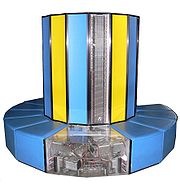- Cray T3E
-
The Cray T3E was Cray Research's second-generation massively parallel supercomputer architecture, launched in late November 1995. The first T3E was installed at the Pittsburgh Supercomputing Center in 1996. Like the previous Cray T3D, it was a fully distributed memory machine using a 3D torus topology interconnection network. The T3E initially used the DEC Alpha 21164 (EV5) microprocessor and was designed to scale from 8 to 2,176 Processing Elements (PEs). Each PE had between 64 MB and 2 GB of DRAM and a 6-way interconnect router with a payload bandwidth of 480 MB/s in each direction. Unlike many other MPP systems, including the T3D, the T3E was fully self-hosted and ran the UNICOS/mk distributed operating system with a GigaRing I/O subsystem integrated into the torus for network, disk and tape I/O.
The original T3E (retrospectively known as the T3E-600) had a 300 MHz processor clock. Later variants, using the faster 21164A (EV56) processor, comprised the T3E-900 (450 MHz), T3E-1200 (600 MHz), T3E-1200E (with improved memory and interconnect performance) and T3E-1350 (675 MHz). The T3E was available in both air-cooled (AC) and liquid-cooled (LC) configurations. AC systems were available with 16 to 128 user PEs, LC systems with 64 to 2048 user PEs.
A 1480-processor T3E-1200 was the first supercomputer to achieve a performance of more than 1 teraflops running a computational science application, in 1998. [1]
After Cray Research was acquired by Silicon Graphics in February 1996, development of new Alpha-based systems was stopped. While providing the -900, -1200 and -1200E upgrades to the T3E, in the long term Silicon Graphics intended Cray T3E users to migrate to the Origin 3000, a MIPS-based distributed shared memory computer, introduced in 2000. However, the T3E continued in production after SGI sold the Cray business the same year.[2]
See also
- History of supercomputing
References
- ^ Researchers Achieve One Teraflop Performance With Supercomputer Simulation Of Magnetism
- ^ Cray Sells First T3E-1350 Supercomputer to PhillipsPetroleum.
External links
- Top500 description of T3E
- Inside Cray T3E-900 Serial Number 6702
- Performance Analysis of the CRAY T3E-1200E, Edward Anderson, Lockheed Martin Services Inc., 1999
Cray Research
Cray-1 • Cray X-MP • Cray-2 • Cray Y-MP • Cray XMS • Cray Y-MP EL
Cray C90 • Cray EL90 • Cray T3D • Cray J90 • Cray T90 • Cray T3E • Cray SV1
Cray Computer Corp.
Cray-3 • Cray-4
Cray Research Superservers
Cray APP • Cray S-MP • Cray CS6400
Cray Inc.
Cray SX-6 • Cray MTA-2 • Cray Red Storm • Cray X1 • Cray XT3 • Cray XD1
Cray XT4 • Cray XMT • Cray XT5 • Cray CX1 • Cray XT6 • Cray XE6 • Cray CX1000 • Cray XK6Categories:- Supercomputers
- 1995 introductions
Wikimedia Foundation. 2010.



